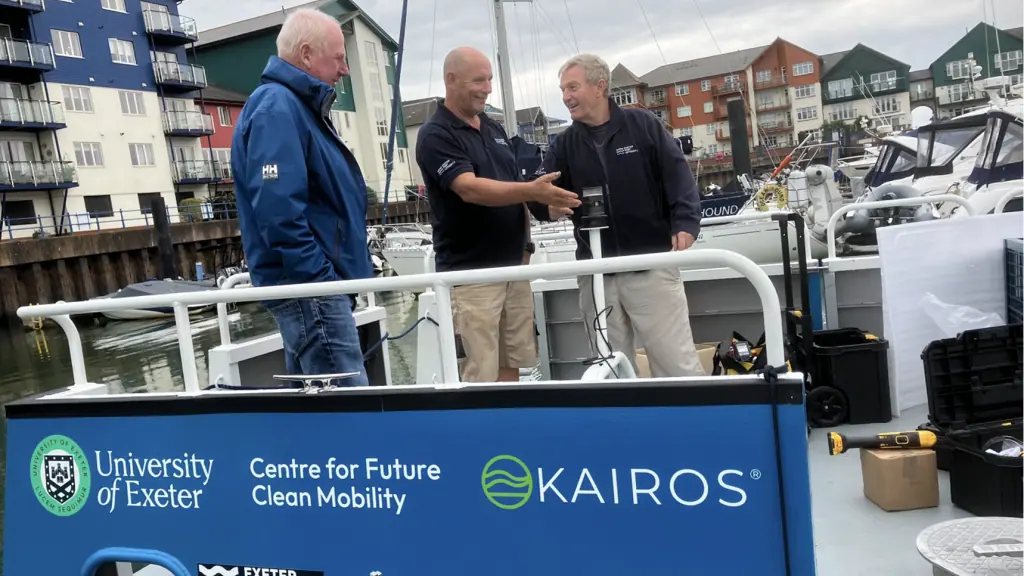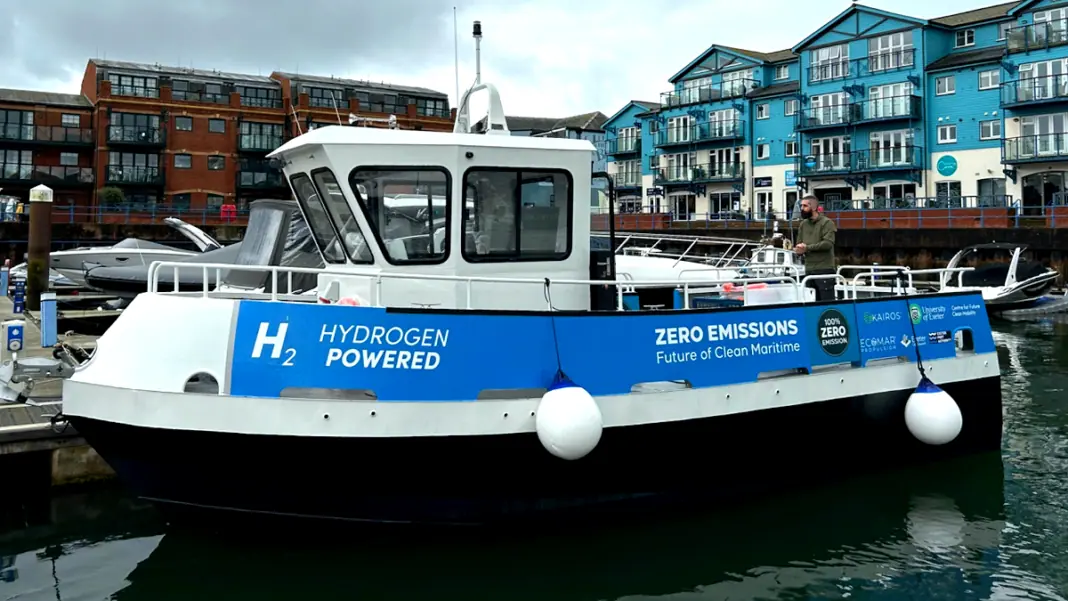This week Exeter Port Authority took delivery of a hydrogen electric workboat made and designed by Ecomar Propulsion for a period of time to assist with the trials and testing of the vessel.
The boat was launched into Exmouth harbour and is currently in the final stages of fitting out. A team from Ecomar Propulsion are currently installing the last items on an innovative new power systems and they are doing it whilst she is afloat!
The boat, MV Dirac, is named after one of the UK’s greatest science minds, Paul Dirac, who won a Nobel prize for his work in quantum physics.
“We called her Dirac because we think that she represents the best of British engineering and innovation,” said Ecomar Propulsion CEO Eugene Bari. “It is fitting that she starts her working life in the South – West where there is a centuries old tradition of seafaring and ground breaking innovation.”
MV Dirac is based on a NATO Combat Ready Boat but she has been radically redesigned internally. She is powered by two 250kW Ecomar Kairos motors and holds 180kWh of Li Ion Batteries which are supplemented by a hydrogen fuel cell that extends the range of the vessel considerably. The hydrogen is supplied in hand-portable BOC Genie bottles which are easily replaced and stored onboard. This means that it is possible to recharge the vessel whenever and wherever necessary.
“The beauty of the hydrogen refuelling is that the port doesn’t need to install expensive equipment. We can carry the bottles to the boat and they weigh about the same as a regular barbeque bottle. We can easily charge the batteries directly from the pontoon as well so it makes the move to clean energy really easy.” Said Grahame Forshaw, Exeter Port Authority’s Harbour Master.
Working alongside the Port and Ecomar, Exeter University’s Centre for Clean Future Mobility will be gathering data from the vessel as she enters an extended period of trials over the next few months.
“We hope to be able to prove to the communities around the River Exe that the transition to clean maritime is easy and safe and above all sensible. We understand that people have reservations about range and safety but the reality is very different from perception and we hope to be able to demonstrate that with the cooperation of forward thinking ports like Exeter, Britain can lead the world in decarbonising our waterways” said Eugene Bari.

Over the next few months the Ecomar team will continue to upgrade and modify the systems as she enters regular service with the Port. By the time the trial is complete she should be able to cope with all the work done by combustion powered boats.
Once Dirac is fully commissioned she will be seen all along the River Exe and the team from the Port and Ecomar are keen to explain how it all works. “Ecomar aim to set up a series of discussion sessions around the River Exe over the next few months. Change requires a two way dialogue, we want to provide answers where we can and also to see what we can learn to make things better for everyone” continued Eugene Bari.
With fewer than 50 hydrogen vessels globally the Dirac represents a step towards a carbon free future for boats. MV Dirac may not look like the start of a revolution but she certainly represents one.
Prof Chris Smith form the Centre for Future Clean Mobility said “We have worked with the Ecomar team for a number of years in projects funded by the government’s Clean Maritime Demonstrator Call, and helped them get their ground breaking hydrogen-battery hybrid propulsion system designed and working. So we’re delighted to see the fruits of all this hard work which is the boat Dirac. We will be taking data from her on the River Exe which will help us improve propulsion systems in other new clean boats.”
Grahame Forshaw said “The harbour team are excited about working with Dirac and putting the hydrogen electric workboat through its paces. The Exe is an excellent proving ground for this type of work due to the many different and varied tidal and weather conditions that we operate in so Dirac will certainly be working hard and proving the concept of clean energy propulsion for the time she is with us.”












